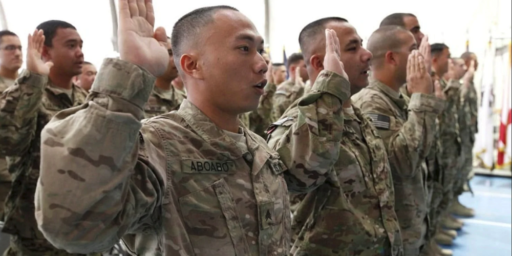Military Attracting Fewer Black, Urban Recruits
The U.S. military is looking increasingly like the Republican party, as black and urban youths become increasingly less willing to volunteer.
Black Americans make up smaller share of military (USAT, p.1)
Long a mainstay of the military, black Americans have made up a shrinking share of enlisted troops since 2000, Pentagon statistics show. The number of black enlisted troops has declined significantly in three military branches from 2000 through 2004 — by 15% in the Army, 23% in the Marines and 11% in the Air Force. The Navy’s number fell only slightly. The overall size of all four branches has stayed roughly the same.
A major reason for the trend is a sharp drop in blacks joining the military, according to a Pentagon analysis conducted in response to questions from USA TODAY. During the four-year period, African-American recruits in all four services fell nearly a third, from 38,034 in 2000 to 26,170 in 2004. Other factors include a rise in black college attendance and the fact that the war in Iraq is more unpopular among blacks than among whites, according to public opinion polls.
[…]
Curtis Gilroy, who oversees the Pentagon’s active-duty military recruiting, calls the drop in black recruits partly a “good-news story.†It shows many minorities now have career options outside the military.
[…]
David Segal, a University of Maryland military sociologist, says the Army will have to “reduce its dependence on African-Americans†and recruit more whites and Hispanics. The percentage of Hispanics in the Army who aren’t officers grew from 9% in 2000 to 11% in 2004. Hispanics are the nation’s largest minority group, but they have lower high school graduation rates than other groups. That makes it harder for them to enlist, Segal says.
[…]
Percentage of blacks among enlisted servicemembers:
Army — 2000: 29.1%, 2004: 24.6%
Marines — 2000: 16.2%, 2004: 12.5%
Youths in Rural U.S. Are Drawn To Military (WaPo, A1)
As sustained combat in Iraq makes it harder than ever to fill the ranks of the all-volunteer force, newly released Pentagon demographic data show that the military is leaning heavily for recruits on economically depressed, rural areas where youths’ need for jobs may outweigh the risks of going to war.
More than 44 percent of U.S. military recruits come from rural areas, Pentagon figures show. In contrast, 14 percent come from major cities. Youths living in the most sparsely populated Zip codes are 22 percent more likely to join the Army, with an opposite trend in cities. Regionally, most enlistees come from the South (40 percent) and West (24 percent).
Many of today’s recruits are financially strapped, with nearly half coming from lower-middle-class to poor households, according to new Pentagon data based on Zip codes and census estimates of mean household income. Nearly two-thirds of Army recruits in 2004 came from counties in which median household income is below the U.S. median.
[…]
Senior Pentagon officials say the war has had a clear impact on recruiting, with a shrinking pool of candidates forcing the military to accept less qualified enlistees — and presumably many for whom military service is a choice of last resort. In fiscal 2005, the Army took in its least qualified group of recruits in a decade, as measured by educational level and test results. The war is also attracting youths driven by patriotism, including a growing fringe of the upper class and wealthy, but military sociologists believe that greater numbers of young people who would have joined for economic reasons are being discouraged by the prolonged combat.
These data aren’t particularly surprising. An Army on a wartime footing is less attractive to those who want to join simply to get job training or college money. At the same time, it is more attractive to those who are patriots or adventure seekers.
Related:
-
Army Doubles Idiot Quotient
Army Recruiting High School Dropouts without GED
Defense Department Seeks to Raise Enlistment Age to 42
Pentagon Creating Student Database for Recruiting
Army Keeping Problem Soldiers to Keep Troop Levels Up
Army Using Video Game as Recruiting Tool
Army Offers 15-Month Enlistment Option
Army Taking Recruiting Holiday
Blue to Green Moving Slowly
Army Recruiters Say They Feel Pressure to Bend Rules
Recruiting Soldiers During Wartime Difficult
Military Recruiters Target Friends and Family
Recruiting During Wartime
RECRUTING AND MORALE
RECRUITING WOES?




No, but I’m sure there is a Maytag in there somewhere …. for the left.
The Post story basically casts the military as exploiting the misfortune of impoverished rural citizens.
What caught my attention was the story’s reliance on data provided by the supposedly nonpartisan National Priorties Project, which you can see is anything but neutral once you start perusing their website–right down to a “cost of war” running graphic and links to MoveOn.org and other antiwar groups.
How about youths from rural areas are more likely to be red-staters, and therefore, supportive of the military and the Mission.
Whereas urban youths are more into their crack pipes…
Nah, they’re just rednecks with no job prospects.
Its clear whats going on– because Al Sharpton and Jesse Jackson are engaging in unpatriotic activity by criticizing the President these people are no longer signing up. This should be grounds for jailing those two terrorist-lovers for sedition.
I suspect more military recruits are from red states, because they tend to be more patriotic, and are probably more likely to support the war.
Also, I hope the military moves away from promoting itself as a “jobs” program. That is one recruiting tool that has always bugged me-sure the military can provide good training, and that training can make you more appealing in the civilian market, but the military is about defending the country, and serving where the president thinks you need to go-it isn’t about getting money to go to school or having a job.